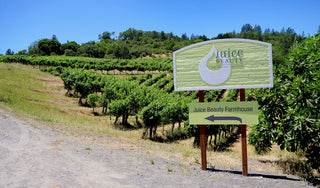The Juice Beauty farm is known for having some of the best grapes in all of Dry Creek Valley. The long hot Healdsburg days following by cool nights create vines that struggle for growth and develop powerful antioxidants, flavors and nutrients. The western side of Dry Creek road is particularly special for Cabernets. The sugars regenerate at night after the heat of the day and complexities and nuances are richer.
Organic Farming is at the core of Juice Beauty’s mission. Certified organic ingredients are produced according to federal standards set by the USDA National Organic Program and regulated by the government. Organic standards address many factors: soil quality, animal raising, pest and weed control, and this form of farming greatly limits all pesticides. Gaining certification is a rigorous process that Juice Beauty started in mid-2018 and we expect to have our certification sometime in 2021. Organic farming not only protects our earth, soil and waterways but organically produced ingredients have been shown to have higher antioxidant levels which can provide amazing benefits for our skin….so Every Organic Drop Feeds the Skin. Juice Beauty will start with the 2019 harvest making and experimenting with the rich grape juice and seed and how we can develop superior ingredients for Juice Beauty’s products.
Since the Juice Beauty farm already had the highest sustainable certification, converting to certified organic is an easier route than taking a conventional farm that has been sprayed with glyphosate/RoundUp. Learning how to farm organically has been a scientific treat for Karen and her husband Howard (aka Dr. Grape). Some of the organic farming techniques include cultivating the owl boxes to control the rodents naturally, misting KELP to replace nutrients (instead of synthetic vitamins), cultivating cover crops and natural grasses in between the vines to keep nutrients in the soil, and hand farming the 10,000+ vines as each vine is touched up to 8 times annually.


